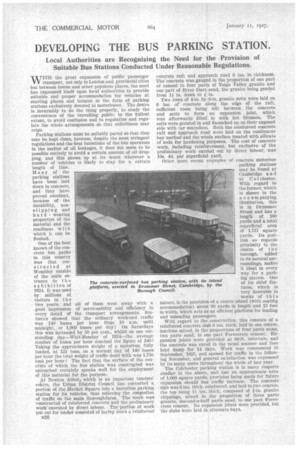DEVELOPING THE BUS PARKING STATION.
Page 46

If you've noticed an error in this article please click here to report it so we can fix it.
Local Authorities are Recognizing the Need for the Provision of Suitable Bus Stations Conducted Under Reasonable Regulations.
WITH the great expansion of public passenger transport, riot only in London and provincial cities but between towns and other populous places, the need has impressed itself upon local authorities to provide suitable and proper accommodation for vehicles at starting places and termini in the form of parking stations exclusively devoted to motorbuses. The desire is invariably to do the thing properly, to study the convenience of the travelling public to the Tallest extent, to avoid confusion and to regularize and regulate the whole arrangements .so that orderliness may reign.
Parking stations must be suitably paved so that they may be kept clean, because, despite the most stringent regulations and the best intentions of the bus operators in the matter of oil leakages, it does not seem to be possibleentirely to avoid a certain amount of oil dropping, and this shows up at its worst wherever a number of vehicles is likely to stay for a certain length of time Many of the parking stations have been laid down in concrete, and they have proved excellent, because of the durability, nonslipping and hard wearing properties of the material and the readiness with which it can be flushed.
One of the best known of the concrete bus, parks in this country was that constructed at Wembley outside of the main entrance to t h e exhibition of 1924. It was used by' millions of visitors in the two years," and all of them went away with a good impression of serviceability and efficiency in every detail Of the transport arrangements. Statistics showed that the ordinary week-end traffic was 140 buses per hour from 10 a.m. until midnight, . or 1,969 buses per clay! On Saturdays this was increased by 50 per cent., whilst on one outstanding. day—Whit-Monday of 1924—the average number of buses per hour reached the figure of 340! Taking the approximate weight of a motorbus, fully loaded, at 12i tons, on a normal day of 140 buses per hour the total weight of traffic dealt with was 1,750 tons per hour The fact that the surface of the concrete of which, the bus station was constructed was untouched certainly speaks well for the employment of this material for the purpose.
M Newton Abbot, which is an important tourists' centre, the Urban District Council. has converted a portion of the Market Square into a motorbus parking station for its vehicles, thus relieving the congestion of traffic on the main thoroughfares. The 'work was constructed of reinforced concrete and the preliminary work executed by direct labour. The-portion of work put out for tender consisted of laying down a reinforced concrete raft and approach road 6 ins, in thickness. The concrete was gauged in the proportion of one part of cement to four parts of Teigu Valley granite and one part of River Dart sand, the granite being graded from 1 in. down to Two rows of 4-in. by 6-in, granite setts were laid on 6 ins, of concrete along the edge of the raft, sufficient room being lift between, the concrete and setts to form an expansion joint, which was afterwards filled in with hot bitumen. The setts were grouted in and flaunched up on their exposed side with tar macadam. Both the reinforced concrete raft and approach road were laid on the continuous bay method and the whole surface treated with silicate of soda for hardening purposes. The cost of concrete work, including reinforcement, but exclusive of the preliminary work carried out by direct labour, was 10s. 4d. per superficial yard.
Other more recent examples of concrete motorbus parking stations may be found at Cambridge an d at C ol cheater. With regard to the former, which is shown in the acco ra.paits.ing illustration, this is in Drummer Street and has a length of 160 yards and a total. superficial area of 1,731 square yards. Its position as regards proximity to the centre of the borough, added to its natural surroundings, makes it ideal in every way for a parking station. One of its chief -features, . which is very desirable in works of this nature, is the provision of a centre island (with seating accommodation) about 60 yards in length and 15 feet in width, Which acts as an efficient platform for loading and unloading passengers.
With regard to the construction, this consists of a reinforced concrete slab 6 ins, thick, laid in one course, machine mixed, in the proportions of four parts stone, two parts sand, to one part Ferrocrete cement. Expansion joints were provided at 60-ft. intervals, and the concrete was cured in the usualmanner and then kept damp for 14 days. Work was commenced in September, 1925, and opened for traffic in the following November, and general satisfaction was expressed by its many users throughout the whole of last year.
The Colchester parking station is in many respects similar th the above, and has an approximate area of 1.000 square yards, provision being made for future expansion should bus traffic increase. The concrete slab was Gins, thick, reinforced, and laid 1n-two courses, the top being 11 ins, thick, composed of i-in. granite chippings, mixed in the proportion of three parts granite, one-and-a-half parts sand, to one part Ferro:crete cement. No expansion joints were provided, but the slabs were laid in alternate bays.




































































































